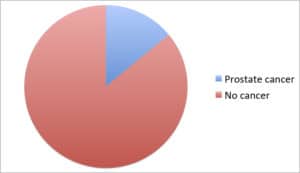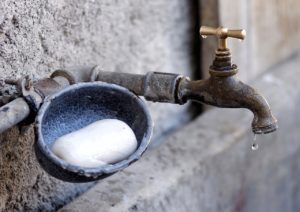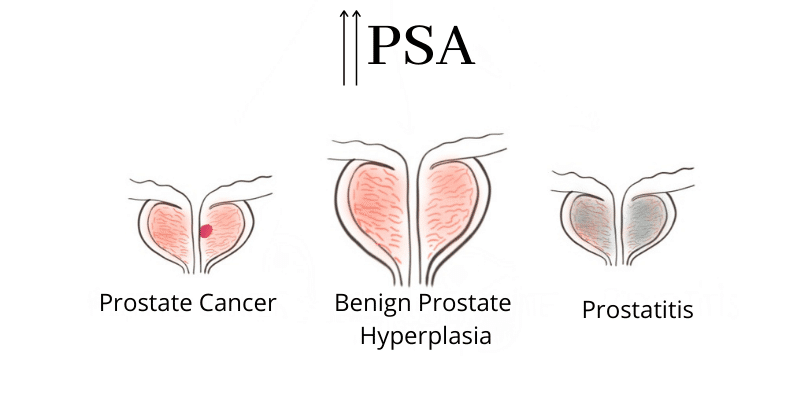That’s how it works. Nobody expects the signs of prostate cancer when they turn 60. Once we start getting older we begin to suffer some health issues. It happens to all of us.
Back pain, headache, small memory losses… and difficulty urinating.
If that’s the case, some questions inevitably come to our mind:
- Should I worry about it?
- Is it bad?
- Do I have prostate cancer?

When it comes to difficulty urinating (or pain, burn while urinating) we ask ourselves: could it be a sign of prostate cancer?
Yes, it could be. But it can also be something else. It’s sometimes due to benign prostatic hyperplasia (BPH ICD 10).
So let’s see what the symptoms of prostate cancer are, and how to tell them from other conditions.
What is the prostate? (And what is it for?)
To understand the signs of prostate cancer, we must know what the prostate is first. And where it is located.
Because most of the symptoms are explained by the prostate’s location. When cancer grows, it pushes the surrounding structures, causing those symptoms.

It is a gland located below the bladder, surrounding the urethra (the channel through which pee comes out). That’s right, part of the urethra runs through the prostate.
Its normal size is that of a nut.
As for the function, it produces part of the semen, around 30% of it. The remaining 70% comes from the seminal vesicles and testicles.
So, as you can imagine, prostate cancer can alter the process of urination and ejaculation.
The signs of prostate cancer
Prostate cancer can be silent. It usually is, at least while it is small. It doesn’t cause any symptoms at that moment.
That’s because it usually grows in the periphery of the prostate, far from the urethra.
After it grows a little, you can start to get some symptoms. These are the most common:
-
- – Difficulty urinating: trouble starting or stopping to pee
- – Burning sensation or pain during urination
- – Frequent urges at night
- – Loss of bladder control: urine escapes unnoticed
- – Decreased flow or velocity
- – Blood in urine
- – Blood in semen
- – Difficulty with erection
- – Painful ejaculation
As you can see, all these signs and symptoms are related to urination and ejaculation.
For example, as the prostate surrounds the urethra, prostate cancer may make it harder to pee.
The tumor will narrow the duct and the urine flow will diminish. That’s when we find it difficult to urinate. Either through trouble starting (it won’t come out) or being unable to stop.
Also, the effort of the bladder against the obstacle can cause a burning sensation or pain…
And so on… many of these signs are due to this obstacle mechanism.
Is it always cancer?
HOWEVER, as we said, most prostate tumors don’t happen in the central gland, but in the peripheral zone. And this zone is far from the urethra.
So, many times, when we have these symptoms they are NOT because of cancer.
They are because of something else… like benign prostatic hyperplasia. This disorder is way more frequent and many men suffer it after a certain age (> 60 years).
What’s more, pain and burn are also caused by prostatitis (an infection of the prostate).
So… how can we tell between cancer (potentially dangerous) and the others (a “pain in the ass” but not so bad)?
How to know whether it is cancer
If you have any of the mentioned signs, you should see a doctor. They will take the steps to rule out cancer.
However, you can read here the different options (it usually takes several):
· RECTAL EXAMINATION
The doctor checks your prostate through your rectum, with a finger. The prostate is in contact with the rectum so this is the way to palpate it.
By doing so, the doctor can check if it is enlarged, if it has hard nodules…
· PSA (Prostate-Specific Antigen)
It is detected through a blood test. The more prostatic tissue you have, the higher value of PSA you have.
It is useful if you have a normal PSA value because that virtually rules out cancer. If your PSA is okay, your prostate is probably ok.
However, if you have a high PSA… then you have more prostatic tissue than normal. Maybe you have BPH (an enlarged prostate).
Prostatitis also causes a high PSA, because of the irritated tissue.
So if PSA is normal then everything is good. If PSA is high you probably need some extra tests to find out what is wrong.

· PROSTATE MRI
You go inside the MRI machine and stay still for around 30 minutes.
Usually, it also requires intravenous contrast so you will need an IV line.
- This test will tell the doctor if there are any suspicious nodules inside the prostate. Also, it will show the prostate cancer stage.
- It will also show if it is a large prostate, but with no malignant nodules (benign hyperplasia).
If there are no nodules, everything’s fine. If there are… you may need a biopsy.
· PROSTATE BIOPSY
The last step. And the most precise one.
It consists of extracting samples from the prostate.
They take them from all sections of the prostate and then some extra from the suspicious nodules in the MRI.
For example, if the MRI shows a nodule in the peripheral upper left gland, they will take a biopsy from that section. But also to the rest of the gland, just in case.
The biopsy will tell if there is a malignant tumor or not.
And if there is, they will take out the prostate through surgery. Or not… But that’s for another post.
Leave a Reply